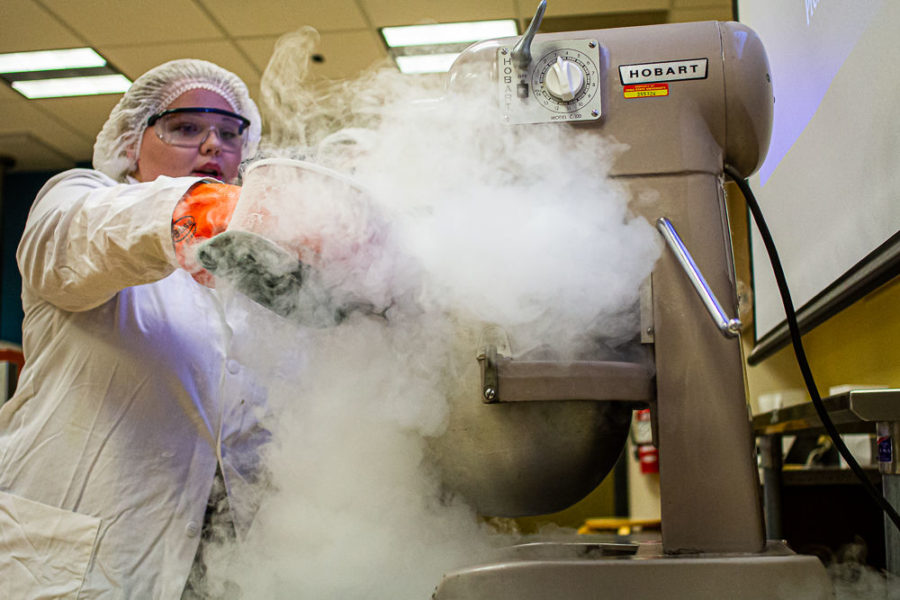Liquid nitrogen ice cream demonstration educates on food science
Garrett Heyd/ Iowa State Daily
Students of College of Human Sciences had a liquid nitrogen demo on making ice cream with the very cold element Thursday in MacKay Hall.
October 10, 2019
A liquid nitrogen ice cream demonstration was presented Thursday as part of the 2019 College of Human Sciences Week, hosted by Iowa State’s Food Science Club.
Maddison Wild, senior in food science, began the demonstration by describing how liquid nitrogen ice cream is made.
“Nitrogen ice cream was created by Iowa State alums,” Wild said. “They opened an ice cream company called Blue Sky Creamery and it gained a lot of popularity.”
Wild said nitrogen ice cream is creamier, fresher and has less fat than traditional ice cream.
The liquid nitrogen ice cream demonstration was a way to educate those attending about the food science major and what careers students can lead in food science.
“We’re kind of the people that help get our food into grocery stores, and so that can be [with] food processing, food quality and food engineering,” Wild said. “All of these are using biological, chemical or engineering principles to adapt to complex food matrices.”
Two members of the Food Science Club, Sarah Schwartz, junior in culinary food science, and Margaret Leonard, junior in food science, tipped a large metal canister to slowly pour liquid nitrogen into a small cooking pot.
Leonard said the metal canister is capable of storing 57 liters, or approximately 15 gallons, of liquid nitrogen. As soon as the small cooking pot begins to fill with liquid nitrogen, a layer of condensation forms and rapidly freezes on the outside, creating a thin layer of frost.
The liquid nitrogen is then moved from the pot to a large electric kitchen mixer containing a mixture of heavy cream, milk, sugar and flavoring, such as vanilla. The liquid nitrogen causes the ingredients of the mixture to freeze quickly, creating smaller ice crystals and a creamier texture.
At the demonstration, the mixture was combined with the liquid nitrogen for about a minute to make vanilla ice cream. The ice cream was then served to attendees with a variety of toppings including whipped cream, chocolate syrup, caramel drizzle, M&M’s and Oreos.
Kathrine Gilbert, assistant teaching professor in the food science and human nutrition department, serves as the adviser for the Food Science Club. She said total attendance for the event is usually between 125 and 150 people.
Wild said the demonstration is one of several events the Food Science Club hosts throughout the year. Wild said the club also participates in activities such as traveling to a food manufacturing plant and selling homemade fudge to students.
Membership in the Food Sciences Club is not limited to food science majors and open to all Iowa State students.







